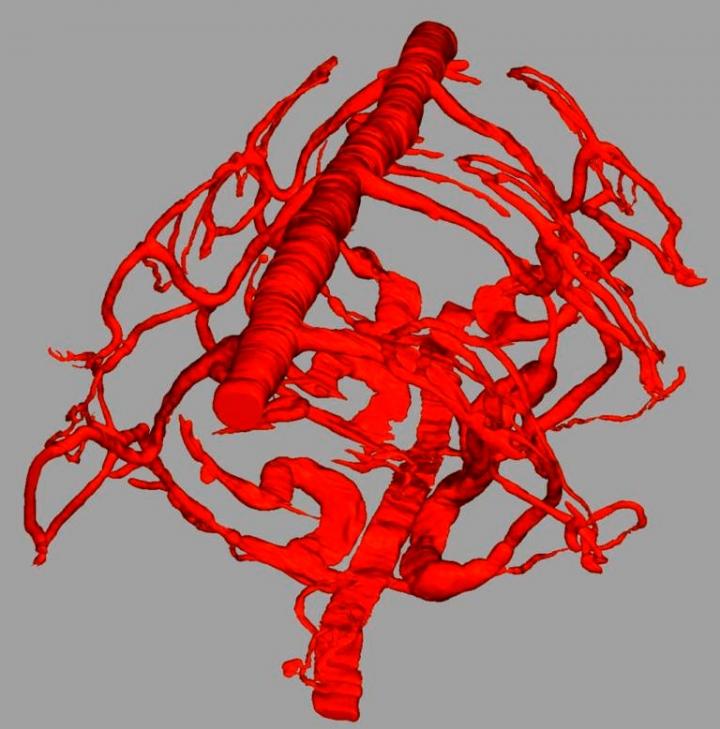A single gene ‘invented’ haemoglobin several times

The Platynereis dumerilii vascular system in three segments
Credit: © Song et al. / BMC Evolutionary Biology
Thanks to the marine worm Platynereis dumerilii, an animal whose genes have evolved very slowly, scientists from CNRS, Université de Paris and Sorbonne Université, in association with others at the University of Saint Petersburg and the University of Rio de Janeiro, have shown that while haemoglobin appeared independently in several species, it actually descends from a single gene transmitted to all by their last common ancestor. These findings were published on 29 December 2020 in BMC Evolutionary Biology.
Having red blood is not peculiar to humans or mammals. This colour comes from haemoglobin, a complex protein specialized in transporting the oxygen found in the circulatory system of vertebrates, but also in annelids (a worm family whose most famous members are earthworms), molluscs (especially pond snails) and crustaceans (such as daphnia or ‘water fleas’). It was thought that for haemoglobin to have appeared in such diverse species, it must have been ‘invented’ several times during evolution. But recent research has shown that all of these haemoglobins born ‘independently’ actually derive from a single ancestral gene.
Researchers from the Institut Jacques Monod (CNRS/Université de Paris), the Laboratoire Matière et Systèmes Complexes (CNRS/Université de Paris), the Station Biologique de Roscoff (CNRS/Sorbonne Université), the Universities of Saint Petersburg (Russia) and Rio de Janeiro (Brazil), conducted this research on Platynereis dumerilii, a small marine worm with red blood.
It is considered to be an animal that evolved slowly, because its genetic characteristics are close to those of the marine ancestor of most animals, Urbilateria(1). Studying these worms by comparing them with other species with red blood has helped in tracing back to the origins of haemoglobins.
The research focused on the broad family to which haemoglobins belong: globins, proteins present in almost all living beings that ‘store’ gases like oxygen and nitric oxide. But globins usually act inside the cells because they do not circulate in the blood like haemoglobin.
This work shows that in all species with red blood, it is the same gene that makes a globin called ‘cytoglobin’ that independently evolved to become a haemoglobin-encoding gene. This new circulating molecule made oxygen transport more efficient in their ancestors, who became larger and more active.
Scientists now want to change scale and continue this work by studying when and how the different specialized cells of bilaterian vascular systems emerged.
(1)Urbilateria is the last common ancestor of bilaterians, i.e. animals with bilateral (left-right) symmetry and complex organs, apart from species with simpler organization such as sponges and jellyfish.
All latest news from the category: Life Sciences and Chemistry
Articles and reports from the Life Sciences and chemistry area deal with applied and basic research into modern biology, chemistry and human medicine.
Valuable information can be found on a range of life sciences fields including bacteriology, biochemistry, bionics, bioinformatics, biophysics, biotechnology, genetics, geobotany, human biology, marine biology, microbiology, molecular biology, cellular biology, zoology, bioinorganic chemistry, microchemistry and environmental chemistry.
Newest articles

Why getting in touch with our ‘gerbil brain’ could help machines listen better
Macquarie University researchers have debunked a 75-year-old theory about how humans determine where sounds are coming from, and it could unlock the secret to creating a next generation of more…

Attosecond core-level spectroscopy reveals real-time molecular dynamics
Chemical reactions are complex mechanisms. Many different dynamical processes are involved, affecting both the electrons and the nucleus of the present atoms. Very often the strongly coupled electron and nuclear…

Free-forming organelles help plants adapt to climate change
Scientists uncover how plants “see” shades of light, temperature. Plants’ ability to sense light and temperature, and their ability to adapt to climate change, hinges on free-forming structures in their…





















